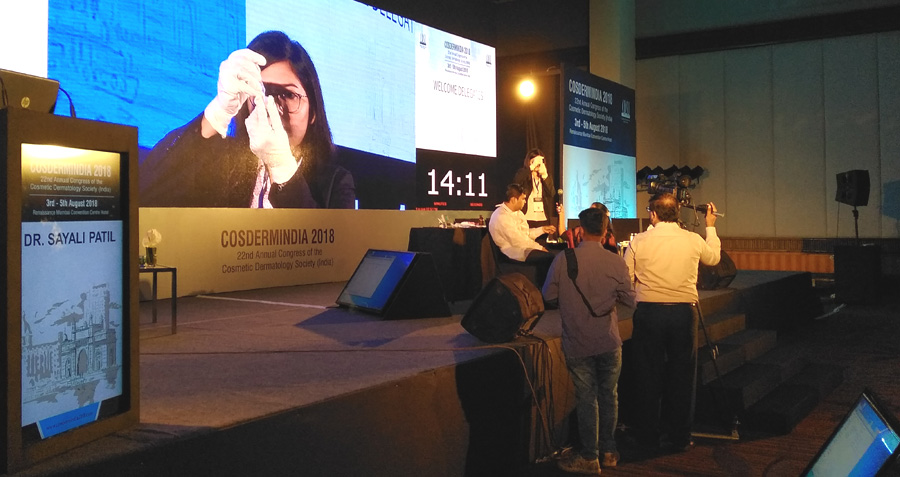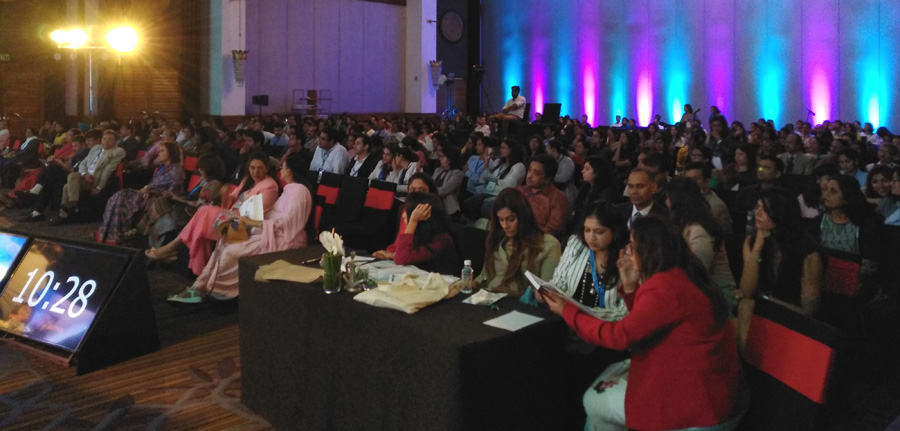Packed with knowledge-rich presentations, a thought-provoking debate, and informative workshop and panel discussion—the Day 1 of CosdermIndia 2018 exposition started on a positive note. A report.
The 22nd CosdermIndia 2018 show kicked off in style on Friday, August 3, 2018, i.e. yesterday. Bedecked by the serene Vihar lake and marvellous greenery in the backdrop, the three-day exposition is packed with knowledge-sharing seminars, panel discussions and hands-on workshops.
The stellar feature of the first day’s seminars had been the Awards session wherein the industry’s reputed dermatology practitioners presented the findings of the innovative procedures employed by them. Dr Wahena Usmani, for instance, discussed how the application of dermaroller can prove useful in vitiligo. The average duration of vitiligo in her study was 7.5 years. Out of seven patients (in the age group of 17 to 38 years) who completed her procedure, four patients showed excellent improvement, one had very good improvement, one had good improvement, and one had no response at all.
Similarly, Dr Vrushali Survade shared the results of her experience about combining fractional CO2 laser and Q-Switched ND:YAG laser (1064nm) or difficult epidermal and dermal pigmentation. In her presentation, Dr Renney Pinto focused on the utility of radiofrequency energy device for non-surgical periorbital and full face tightening, Dr Rajvee Rajshakha detailed her experience of using CO2 laser excision in treating uncommon skin disorders, and Dr Ashni Pandya discussed how performing periorbital rejuvenation can be useful in different skin types.
Describing a few interesting procedures such as hair follicle simulation, areola reconstruction, vitiligo camouflage, scar camouflage, semi-permanent make-up, etc. that are available for medical aesthetics practitioners today, Dr Sayali Patil, gave a demonstration of tattoo removal without laser at the event.

How risky are home-based devices?
Chaired by Dr Dipak Kulkarni and moderated by Dr Rishi Parashar, the event had an interesting debate on home-based devices. Ms Gulhima Arora spoke for the contention that home-based devices should be used by patients while Dr Shehnaz Arsiwala put forth her views speaking against the contention.
Stating that even the use of professional devices may have sinister complications, Ms Gulhima argued that all home-based devices should not be discarded as unreliable or risky. The pace of aesthetic devices at home for rejuvenation, hair removal, etc. has already set in. The popularity of home-based devices, such as safety razors, UV phototherapy units, electrolysis machines, is growing due to various benefits they offer to consumers. Besides the cost effectiveness and easy access, consumers find them convenient to use them at any time, anywhere and at the privacy of their homes. Stating that even Food & Drug Administration (FDA) has a page dedicated to appropriate use of home-based devices to help and educate consumers, encouraging them to use them in a risk-free manner.
Arguing that the home-based devices cannot replace qualified medical aesthetics practitioners, Dr Shehnaz said that there exists a high risk of these devices implying one thing but people believing them to be doing something else. Expressing concern about various laser-based devices being freely available on popular e-commerce platforms such as Amazon, she debunked the myths of their being affordable and warned the audience members of their potential ill-effects on patients’ health. The home-based devices, she claimed, are ridden with a series of issues such as power output not being described, parameters are not being adjustable, safety not being tested, and efficacy being compromised.

Drive carefully: Speed-breakers ahead!
A Speed-Breakers session that focused on unexpected complications that may arise during or after medical aesthetic procedures was another highlight of yesterday’s event. Moderated by Dr. Rekha Sheth, the session was presented in a panel discussion format wherein eminent practitioners shared their experiences of how complications may arise, and how to best to avoid them. The panelists included Dr Aparna Santhanam, Dr Niteen Dhepe, Dr Rungsima Wanitphakdeedecha, Dr Seemal Desai, Dr Shehnaz Arsiwala, and Dr Snehal Sriram. The discussion highlighted that besides adherence to due procedures and best practices, even innocuous-looking scenarios may lead to complications. The panelists, for instance warned the audiences not to conduct a procedure when either the practitioner or the patient is likely to undertake a long distance travel shortly after the procedure.
A strong, positive response
Organized by Cosmetic Dermatology Society of India (CDSI), the exposition received nearly 650 delegate registrations on Day 1 as against last year’s 600. The event has also seen the support of 41 top brands in the cosmeceuticals and medical aesthetic equipment in skin care and hair care segments.

Commenting on the event’s format and the selection of topics, Dr Rekha Sheth, Founder and President of CDSI, said: “The whole idea is sharing information that is relevant and useful. We select topics that are controversial that trigger a thought process and scrutiny. For instance, the speed breakers session was meant to sensitise and educate the fellow practitioners about how to handle complications by following a certain best practices.”

